
A home run out of the transfer portal for the Wildcats.
We’ll continue our reviews of Northwestern women’s basketball players with Taylor Williams, who was productive in her sixth and final season of collegiate basketball.
The Good
Last season, Northwestern hauled in its biggest transfer class in portal history, and Taylor Williams was at the center of it. The 6-foot-2 forward transferred to NU after three seasons at Western Michigan, where she shattered multiple school records, before spending last season at fellow Big Ten rival Michigan.
Williams proved why the ‘Cats coveted her with her performance this season through both consistency and nightly production. She started 26 games for the ‘Cats and averaged 11.7 points with a team-high 9.4 rebounds. Williams scored in double figures 16 times, with multiple 20+ point performances, and garnered 11 double-doubles, which ranked sixth among Big Ten players. She was gritty on the boards and excelled as a rim protector, as she posted 15 games with at least 10 rebounds. Her strongest offensive performance of the season came during the second game against Loyola Chicago, where she dropped 22 points and 11 rebounds. Defensively, Williams’ hallmark showing was against Purdue, where she grabbed 16 boards along with five steals and two blocks — both season highs.
Taylor Williams ➡️ Double-Double Machine ⚙️
1️⃣3️⃣ Points
1️⃣1️⃣ Rebounds pic.twitter.com/v6285Mj3Rc— Northwestern Women’s Basketball (@nuwbball) December 16, 2024
Beyond the stat sheet, Williams brought stability in the paint to a ‘Cats team that desperately needed it. She helped NU on both ends with her physicality and versatility, fitting in seamlessly in her first and only season in purple.
The Bad
There were not too many holes in Williams’ game — she clearly improved on both ends since her early days at Western Michigan. Her role as a facilitator, however, was something left to be desired. She only averaged 2-3 assists per game, and sometimes went an entire game without recording one. Williams also struggled with taking care of the ball when moving in transition. She recorded at least one turnover in 23 of her 26 starts and averaged 2.7 turnovers per game, the highest among the starting lineup. Williams had a handful of games with over three balls given away, with one game totalling eight turnovers. Assists and turnovers have an inverse relationship, and Williams would likely have garnered more assists had she taken care of the ball more efficiently. Then again, Williams isn’t solely to blame; the entire team continuously shot itself in the foot with self-inflicted errors, as they collectively averaged 14 turnovers a game this season.
Williams also struggled at times from the free-throw line, shooting 59.3% on the season, below the team average of just under 67%. This was largely because she took more free throws than any other Wildcat, but she still left a lot of free points on the court.
The Bottom Line
Before the season, head coach Joe McKeown touted Williams’ “ability to play multiple positions and defend all over the court” as a crucial asset for the Wildcats this season. He also proclaimed her veteran presence as a necessity for the ‘Cats, with Williams herself promising she would “lead by example” and do the little things.”
She lived up to the hype this season with her rebounding and consistent scoring. While struggles with turnovers and at the free-throw line may have prevented Williams from hitting another gear, she was exactly what the ‘Cats wanted this season out of the veteran.
Williams could have hung up the cleats, but she chose to extend her career with Northwestern, bringing the team toughness and serving as a role model. Even though she won’t be with the Wildcats next year, her leadership likely helped the team long-term.